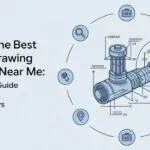When it comes to securing intellectual property rights, a well-prepared patent drawing can make all the difference. From utility patent drawings to design patent illustrations, the inclusion of hatching and shading plays a vital role in how effectively your invention is communicated to the patent examiner. At The Patent Drawing Services, we specialize in crafting high-quality, USPTO-compliant patent illustrations that not only meet regulatory standards but also enhance your application’s chances of approval.
In this blog, we break down the importance of hatching and shading, their purpose in professional patent drawings, and how our expert team ensures every detail is done right.
What Is Hatching in Patent Drawings?
Hatching is used in patent drawings to show sectional views—essentially revealing the internal structure of an object by slicing it along a plane. It is common in utility patent drawings, especially for mechanical components or processes.
According to USPTO and PCT standards:
- Lines should be drawn at a consistent 45° angle unless specified otherwise
- The spacing must be uniform and not overly dense
- Hatching should not obscure reference numerals or other key parts
Our skilled draftsmen use CAD and vector-based software to ensure precise hatching that visually clarifies complex components while adhering to PTO requirements.
The Importance of Shading in Design Patent Drawings
Shading is typically used in design patent drawings to indicate the surface contours, depth, and three-dimensional form of a product. It helps differentiate curved, flat, or angular surfaces and gives examiners a clearer understanding of the object’s aesthetic and structural features.
However, incorrect shading—or overuse of it—can lead to office actions or delays. At The Patent Drawing Services, we balance shading to highlight necessary details without compromising clarity or compliance.
Why Hatching and Shading Must Be Done Right
Incorrect or inconsistent use of hatching and shading is one of the most common reasons drawings are rejected by patent offices. Poorly executed illustrations can:
- Obscure important details
- Misrepresent your invention
- Lead to longer approval times or even rejection
By choosing a professional patent drawing service, you ensure your invention is represented clearly, accurately, and in accordance with USPTO guidelines. We also accommodate drawings for WIPO, EPO, and other regional IP offices.
Why Choose The Patent Drawing Services?
We stand out in the industry with unmatched precision and speed. Here’s why inventors and attorneys across the globe trust us:
- 1-Day Turnaround: We deliver high-quality utility and design patent drawings within 24 hours.
- All Formats Accepted: Whether it’s input in hand sketches, PDFs, or CAD, and output in PDF, TIFF, SVG, or DWG—we handle all.
- 100% PTO Compliant: Every drawing adheres to USPTO, WIPO, and EPO guidelines.
- Free Iterations: We offer unlimited revisions until you’re fully satisfied.
- Most Affordable in the U.S.: Premium quality without a premium price.
We also accept submissions via various platforms. For example, you can find us on: Wellfound | Sitejabber | Trustpilot | CrunchBase






